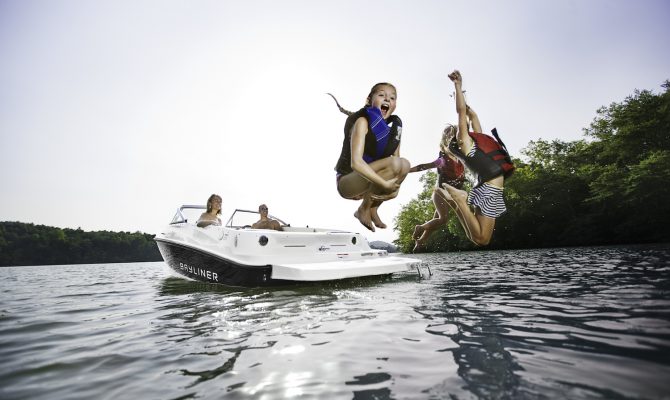Swimming from the family boat is so popular in some Heartland waters that designated swimming zones are established, where boaters are encouraged to anchor in areas surrounded by no-wake zones to concentrate the amphibious activities and keep the swimmers separated from vessels operating at higher speeds.
In some waters, rafting parties consisting of two to several dozen boats tie-up at anchor, or boats are beached beam to beam, to allow like-minded occupants to socialize while sharing the combined fun of boating and swimming — often with more people cooling off in the water than aboard the boats themselves.
Swim-Friendly Features
The popularity of the swimming option hasn’t gone unnoticed by boat manufacturers, who now offer swim platforms in sizes that may rival the boat’s deck space in square footage. Factory-equipped and after-market swim platforms can be multi-level affairs plumbed with hot and cold shower hoses and fitted with remote stereo controls and custom lighting. Some swim platforms offer power ladders or are themselves auto-retractable. Some deck boats and many pontoon models accommodate swimmers from both the bow and stern, with boarding ladders fore and aft, plus all manner of slides (inflatable, portable or permanent) and even mini-diving boards as options.
Safe Swimming
As fun and refreshing as swimming around a boat may be, there is a degree of risk involved. Because it takes place in the water, the threat of drowning is always a concern and swimmers should wear approved flotation devices. It should go without saying that swimmers should stay clear of the motor and propeller; even when powered down, these units can be harmful when touched or kicked.
Where the swimming takes place is also an important consideration. Anchoring over a soft bottom in water free of obstacles and deep enough to accommodate someone jumping off the swim platform is preferable to a shallow, rocky bottom. Diving headfirst off a boat should be avoided unless the water is confirmed to be deep and clear of hazards.
Swimming in any current should be discouraged; ditto swimming from a drifting boat. Either circumstance can result in swimmers becoming separated from the craft and perhaps unable to return to the boat under their own power. Even if a designated observer is left aboard — and posting someone responsible for doing so is strongly recommended — a swimmer separated by drift and/or current may mean the boat needs to be started and put in gear to pick-up the person, an action that carries its own dangers.
Even anchored boats may swing from deep water to shallow water, or over obstructions, so care must be taken that the swimming area is scouted and determined to be safe based on the abilities of those involved. The operator of the boat should determine those skill levels and discourage any of his/her passengers from entering the water that he thinks may not be capable of maintaining a safe swimming attitude.
Running a line off the back of the boat, with a life ring or throwable float tied to the end, is always a good idea, to offer swimmers extra assistance and instant contact with the craft if needed.
Swimming Do’s and Don’ts
- DO have the swimmers don flotation devices and enter the water gradually, feet first, until the depth and bottom structure are determined.
- DON’T leave the boat’s engine running while swimmers are in the water. Accidentally put into gear, a suddenly rotating propeller can be deadly to swimmers, as can carbon monoxide (CO) fumes emitted from the engine’s exhaust.
- DO make sure there are plenty of flotation devices or inflatables in the water with the swimmers to use if needed.
- DON’T swim in the area of any boats spewing generator exhaust. Houseboats especially can concentrate CO fumes near the boat, often at the stern, a popular swimming spot.
- DON’T ever swim in a marked channel, even if there are no boats around. You never know when a boat with limited maneuvering abilities will come along.
- DO make sure there’s an easy way for swimmers to get back on the boat, and that everyone planning to go in for a swim is capable of using the ladder or ladder/platform combo to get back aboard.
- DON’T allow swimming under the boat. Attempting to surface under a hull that has shifted position or misjudged in size risks a head injury that can lead to drowning.
- DO post a designated observer to stay aboard and keep track of swimmers, preferably someone who can provide assistance, make certain the boat stays anchored and operate the boat if needed.
- Don’t swim around docked boats or in marinas. In addition to the risk posed by boats coming and going in tight quarters, craft that are plugged into AC shore power can leak electricity into the water, either from the boat or from the marina’s electrical systems. Electric boat lifts and underwater lighting of slips add to the very real threat of Electric Shock Drowning (ESD) for swimmers in marina areas.
Author: Dan Armitage is a regular contributor to HeartLand Boating magazine




